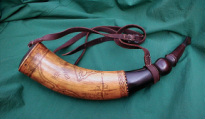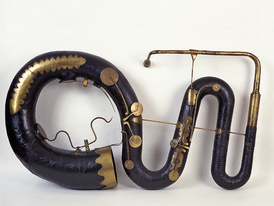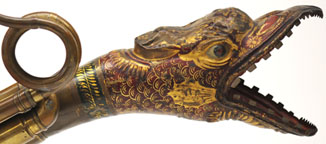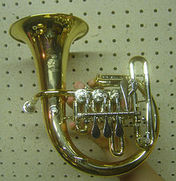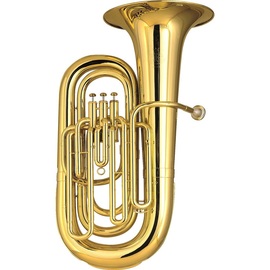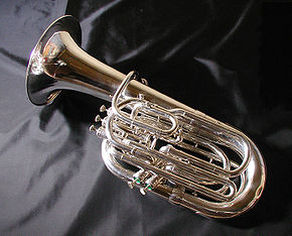500-1810
|
1590 ~ The Serpent: After composers searched for an instrument to fulfill the "empty sounding" low end of orchestra's The oddly shaped "Serpent" was invented by a Frenchman named Edme Guillaume. It features a long, curvy and Snake shaped hence its name. The mouthpiece was made traditionally of wood, bone, ivory, oxhorn and ceramic but brass and bronze versions do exist. The largest Serpent known to exist has the nickname "Anaconda".
|
1810-1893
|
1810 ~ The Ophicleide: In Dublin, Ireland a Bugle maker named Joseph Halliday created a massive contrabass instrument called the Ophicldide which in Greek means "Serpent Stopper", which inevitably took away the Serpent's thunder in the music world. The Ophicleide has keys and pads like a saxophone. After many attempts to fuse the Ophicleide and the Saxophone together by making the Ophicleide have a woodwind mouthpiece but the body of an Ophicleide Joseph Halliday stopped. Below is a short video of the B♭ Ophicleide.
|
|
|
1820- The Russian Bassoon
The Russian Bassoon, despite its name isn't Russian nor is it a bassoon, it actually originates from Belgium. The Russian Bassoon is a configuration of the Ophecleiede that consists of two main pipes that meet at a wooden joint in the bottom. The Russian Bassoon also has a very interesting Snake-Like bell shown in the photo to the left. |
|
Circa 1830- The Helicon
The Helicon was invented in Russia for one reason, to have a mobile low brass instrument for the marching bands. Most Helicon's exist in B Flat but others exist such as:
|
|
|
1840- The Tuba / Miraphone Tuba
Patented in 1850 by Wilhelm Wieprecht The modern tuba was born. The Tuba comes in a range of keys including Bb Flat, CC, E Flat, F and GG. The Compensating Valve System was invented for the Tuba to give it a full and true sound using keys and valves. The Miraphone Tuba was also patented in 1840. The Miraphone Tuba has four rotary keys, The bell can face forward like a marching band styled tuba or be faced up like a concert tuba. |
|
1843 - Saxhorn
The Saxhorn, not to be confused with the military rocket launcher, is a Bass Brass instrument invented and patented by Saxophone founder Adolfe Sax. His intent by making this is to contibute to his "Family of Brasswind's" he was working on. Modern Saxhorns come in: Sopranino/Soprano (E-Flat), Soprano/Alto (B-Flat), Alto/Tenor (E-Flat), Tenor/Baritone (B-Flat), Baritone/Bass (B-Flat), Bass (E-Flat) & Contrabass (B-Flat) |
|
|
1853 - The Wagner Tuba
The Wagner Tuba, despite its name is actually a horn because of its horn mouthpiece. The Wagner tuba has a very soothing and relaxing B-Flat or F tone. The Wagner Tuba is a very difficult instrument to play and when it is played incorrectly it might break. The Wagner Tuba has a Bell facing slightly to the right, unlike any other instrument related to the Tuba. |
|
1893 - The Sousaphone
The Sousaphone was made primarily for marching band is a very large and shaped very differently then a concert tuba. It consists of a large tube that goes around the player's waist that leads to the bell that goes over the head of the player facing forwards and the keys are hang in front of the player. The Sousaphone is a very expensive instrument aswell, it is not hard to spend over $10,000 on one Sousaphone. |

